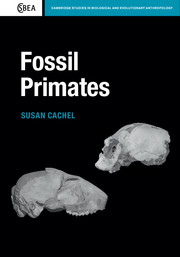Book contents
- Frontmatter
- Dedication
- Contents
- Acknowledgments
- Preface
- 1 Introduction: primates in evolutionary time
- 2 Primate taxonomy
- 3 Fossils and fossilization
- 4 The world of the past
- 5 The lifeways of extinct animals
- 6 Evolutionary processes and the pattern of primate evolution
- 7 Primate origins
- 8 The Paleocene primate radiation
- 9 The Eocene primate radiation
- 10 The Malagasy primate radiation
- 11 The Oligocene bottleneck
- 12 Rise of the anthropoids
- 13 The platyrrhine radiation
- 14 The Miocene hominoid radiation
- 15 The cercopithecoid radiation
- 16 Late Cenozoic climate changes
- 17 Conclusions
- References
- Index
2 - Primate taxonomy
Published online by Cambridge University Press: 05 April 2015
- Frontmatter
- Dedication
- Contents
- Acknowledgments
- Preface
- 1 Introduction: primates in evolutionary time
- 2 Primate taxonomy
- 3 Fossils and fossilization
- 4 The world of the past
- 5 The lifeways of extinct animals
- 6 Evolutionary processes and the pattern of primate evolution
- 7 Primate origins
- 8 The Paleocene primate radiation
- 9 The Eocene primate radiation
- 10 The Malagasy primate radiation
- 11 The Oligocene bottleneck
- 12 Rise of the anthropoids
- 13 The platyrrhine radiation
- 14 The Miocene hominoid radiation
- 15 The cercopithecoid radiation
- 16 Late Cenozoic climate changes
- 17 Conclusions
- References
- Index
Summary
What is taxonomy?
Taxonomy is the study, identification, and sorting of organisms. It is sometimes satirized as mere “beetle-collecting,” but both Darwin and Wallace began as ardent hunters of beetles and emerged as co-discoverers of natural selection (Berry & Browne, 2008). At its simplest level, taxonomy is a highly practical exercise. Taxonomists identify things. For example, exterminators examining insects that are infesting a house are doing taxonomy when they identify the culprit species; fish biologists are doing taxonomy when they identify fish species in a freshwater lake. A more complex level of taxonomy is classification. This is the formal, scientific identification and categorizing or sorting of organisms. A scientifically accepted group of organisms of any rank is then called a taxon (plural, taxa). The dataset of organisms being studied is provisionally called an operational taxonomic unit (OTU), until a decision is made about the final sorting.
Members of the public often consider taxonomy to be merely mindless and obsessive collecting, saving, and cataloguing, but it is much more than this. For example, the correct identification of pests or vermin afflicting domesticated plants and animals is necessary for the preservation of an adequate food supply; the correct identification of pathogens responsible for human disease is necessary for the maintenance of public health. Conservation biologists working within nature reserves must be able to identify hundreds of species, assess biodiversity, and predict the likelihood of maintaining biodiversity within a reserve. Some recent taxonomic revisions have major effects on both human health and mammal conservation. Anopheles mosquitoes with no discernible physical distinctions have been newly separated into multiple species based on DNA differences. Some of these species spread malaria to humans, while others do not (Paskewitz, 2011). The giraffe has recently been separated into six or more species, and the African elephant has been separated into two distinct species. The African lion exists in two separate subspecies, and one of these has only 500 individuals dispersed across eight West and Central African nations. Instead of being widespread and abundant, these large, well-known, and beloved mammals may therefore be highly endangered taxa (Conniff, 2010; Patterson, 2013).
- Type
- Chapter
- Information
- Fossil Primates , pp. 14 - 35Publisher: Cambridge University PressPrint publication year: 2015
- 1
- Cited by



